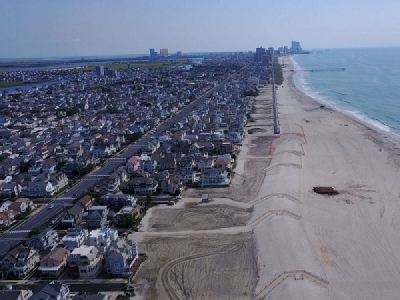
Posted on October 12, 2017
By Nanette LoBiondo Galloway, ShoreNewsToday
After three hurricanes temporarily halted the dune building project on Absecon Island, the dredge Lindholm has returned to the area and sand is being pumped onto the beach once more.
Meanwhile, the city is completing negotiations with the state Department of Environmental Protection and the U.S. Army Corps of Engineers on the design and installation of a permanent drainage system that everyone hopes will solve the city’s drainage issues.
The dune project resumed Oct. 1, and as of Friday, Oct. 6, the project had reached Quincy Avenue.
“It’s expected to get to Rumson and Sumner avenues by next week,” Army Corps spokesman Ed Voight said Friday.
Voight said the hurricanes kept seas rough for several weeks, and the contractor, Weeks Marine Inc., had commitments in other parts of the state.
As of Friday, the project was expected to shift in about 10 days to Longport, where the contractor will continue building the dune working north from 29th Avenue to Sumner Avenue, he said.
The entire dune is expected to be completed by December, but it will take most of the winter to complete the installation of a permanent drainage system in Margate.
“Once the design is completed, it will go out to bid, which takes a few months,” Voight said.
City officials previously told anxious residents the entire project would be completed by the start of summer 2018, but no timeline has been set to complete the drainage project, Voight said.
Margate Administrator Richard Deaney updated commissioners and the public Thursday, Oct. 5, about the status of the project and outlined the city’s key points in the negotiations process.
Crossovers have been completed at many street ends, mats laid from the bulkhead to the landward toe of the dune, and the grade of the beach between the bulkhead and dune restored to pre-project levels.
Temporary measures have been taken to prevent a repeat of the excessive ponding that occurred earlier this year when storm water collected in the excavated areas behind the dune and water did not percolate within 24-36 hours as the Army Corps expected.
A temporary drainage system required by the court is still being installed, but it’s the permanent drainage system, which includes a lateral pipe the entire length of Margate and 13 outfall pipes, that is expected to solve most of Margate’s drainage problem.
The temporary system includes pumps connected to discharge lines that run under the dune and pump water automatically when water accumulates behind the dune.
For the permanent drainage system to be completed by late spring, engineering has to be completed within 45 days and an agreement between the state and city put into writing, Deaney said.
Margate’s engineers have provided input and approved the preliminary design, which was previously estimated to cost about $10 million.
Deaney listed the city’s eight-point negotiation strategy.
The entire drainage system will be paid for with federal funds and the drainage pipes will be under the sand and undetectable by beachgoers until they reach the ocean. The design will be sufficient for a 100-year storm and swiftly carry storm water to the ocean, “vastly improving Margate’s street-end flooding problems in most instances,” Deaney said.
“The beaches will no longer experience the ponding issues caused solely by the original drainage solution that Margate has known to be unsatisfactory throughout the court struggle,” Deaney said.
The city will assume normal maintenance for the system, similar to what the city already does for its existing drainage system, and will partner with the state on future costs associated with replacing or augmenting any and all parts of the system, Deaney said.
However, the city will not incur any costs associated with beach replenishment, which could save it millions of dollars over the next 50 years.
Ventnor recently underwent a third replenishment of its dune system, which was built in 2004 and is expected to last until 2053, at a cost of $440,917.
The replenishment cycle depends on the severity of erosion caused by storms but could be required every three years, according to the DEP’s Division of Coastal Engineering. Normally, the cost of replenishment is split among federal, state and local governments, with the federal government picking up 65 percent of the total cost. The remaining 35 percent is split between the state and municipality, with the state contributing 75 percent and the municipality the remaining 25 percent.
Any work the city does to street ends to tie it in with the new drainage system will be bid and contracted by the city and fully reimbursed by the DEP, Deaney said.
The commission expects to take action to approve the agreement at its Oct. 19 meeting, Deaney said.
Source: ShoreNewsToday





